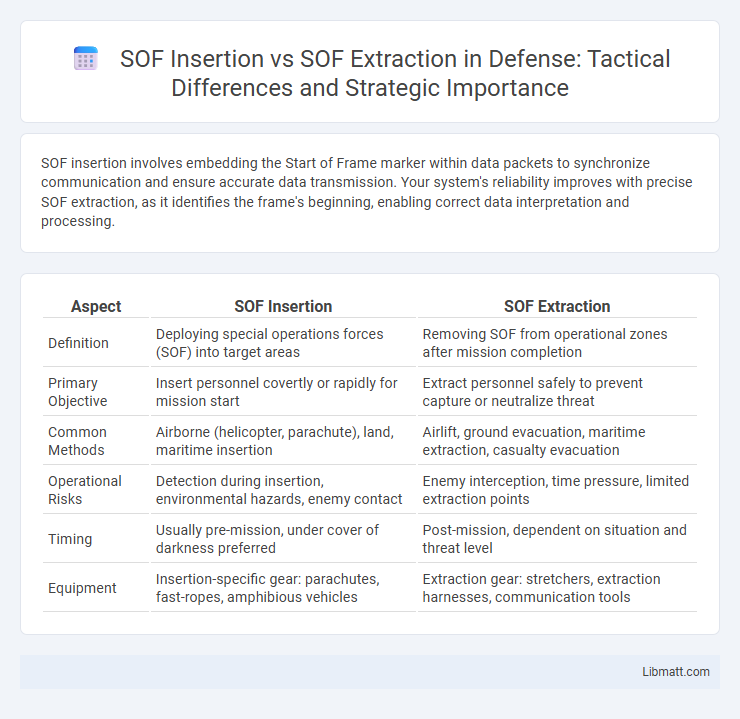SOF insertion involves embedding the Start of Frame marker within data packets to synchronize communication and ensure accurate data transmission. Your system's reliability improves with precise SOF extraction, as it identifies the frame's beginning, enabling correct data interpretation and processing.
Table of Comparison
| Aspect | SOF Insertion | SOF Extraction |
|---|---|---|
| Definition | Deploying special operations forces (SOF) into target areas | Removing SOF from operational zones after mission completion |
| Primary Objective | Insert personnel covertly or rapidly for mission start | Extract personnel safely to prevent capture or neutralize threat |
| Common Methods | Airborne (helicopter, parachute), land, maritime insertion | Airlift, ground evacuation, maritime extraction, casualty evacuation |
| Operational Risks | Detection during insertion, environmental hazards, enemy contact | Enemy interception, time pressure, limited extraction points |
| Timing | Usually pre-mission, under cover of darkness preferred | Post-mission, dependent on situation and threat level |
| Equipment | Insertion-specific gear: parachutes, fast-ropes, amphibious vehicles | Extraction gear: stretchers, extraction harnesses, communication tools |
Understanding SOF Insertion and Extraction
SOF insertion involves embedding a Start of Frame (SOF) marker at the beginning of a data packet to indicate the start point for data interpretation. SOF extraction is the process of identifying and removing this marker from the incoming data stream to isolate the actual payload for further processing. Mastery of SOF insertion and extraction ensures synchronization in communication protocols, improving data integrity and transmission efficiency.
Key Objectives of SOF Insertion Operations
SOF insertion operations primarily aim to deploy specialized forces into hostile or denied areas to conduct reconnaissance, direct action, and unconventional warfare. These missions focus on precision, stealth, and speed to ensure insertion without detection or compromise. Successful SOF insertion enables immediate operational capabilities and sets the foundation for mission success in complex environments.
Primary Goals of SOF Extraction Missions
SOF extraction missions primarily focus on safely recovering personnel or high-value assets from hostile or denied environments with minimal risk and maximum stealth. These operations prioritize rapid, covert movement, secure communication, and precise coordination to ensure successful retrieval under adverse conditions. Your safety and mission success depend on seamless integration of intelligence, surveillance, and tactical support throughout the extraction process.
Planning Considerations: Insertion vs Extraction
Planning considerations for SOF insertion prioritize stealth, terrain analysis, and secure infiltration points to ensure covert entry into hostile environments. SOF extraction planning emphasizes contingency routes, rapid exfiltration methods, and secure extraction zones to minimize exposure during withdrawal. Your mission's success hinges on balancing these factors to optimize operational security and tactical efficiency.
Methods and Platforms for SOF Insertion
SOF insertion methods vary from software-based techniques, such as bit stuffing and byte stuffing, to hardware-level approaches involving dedicated communication controllers and FPGA platforms. Common platforms for SOF insertion include embedded systems, microcontrollers, and real-time operating systems that ensure precise frame alignment and synchronization in data communication. To optimize your communication protocol, choosing the appropriate insertion method and platform is essential for maintaining data integrity and minimizing transmission errors.
Extraction Techniques Used by SOF Units
SOF extraction techniques emphasize stealth and rapid mobility, utilizing methods such as helicopter fast-roping, static line parachuting, and high-speed vehicle exfiltration. These approaches enable operators to evade enemy detection, quickly secure personnel or intelligence, and maintain operational momentum in hostile environments. Specialized equipment like GPS-guided extraction beacons and covert communication systems enhance coordination and situational awareness during complex SOF extrication missions.
Tactical Challenges in Insertion Operations
SOF insertion operations face significant tactical challenges, including securing landing zones under hostile conditions, avoiding enemy detection during approach, and coordinating precise timing with supporting elements. Navigating rugged terrain, adverse weather, and limited intelligence further complicates mission success. Your team must adapt swiftly to dynamic threats to maintain operational secrecy and effectiveness during insertion.
Security Risks During SOF Extraction
SOF extraction poses significant security risks as it involves accessing sensitive Start of Frame data, which can be exploited for unauthorized data interception or system manipulation. During SOF extraction, attackers may use sophisticated techniques to extract cryptographic keys or manipulate frame timing, compromising network integrity. Ensuring robust encryption and secure access controls is crucial to protect Your communication systems from vulnerabilities associated with SOF extraction.
Comparing Equipment Needs: Insertion vs Extraction
SOF insertion requires specialized parachuting gear, advanced navigation systems, and covert communication devices to ensure silent and precise deployment behind enemy lines. In contrast, SOF extraction prioritizes high-speed, heavily armored transport vehicles or helicopters equipped with rapid extraction tools and secure extraction zones to minimize exposure during withdrawal. Both operations demand mission-specific equipment but differ significantly in mobility and stealth capabilities tailored to insertion's covert entry and extraction's swift exit.
Lessons Learned from Real-World SOF Operations
SOF insertion requires meticulous planning and stealth to ensure mission success, whereas SOF extraction demands rapid adaptability and secure communication to safely withdraw forces. Lessons learned from real-world SOF operations emphasize the critical role of situational awareness, real-time intelligence, and contingency planning in minimizing risks during both insertion and extraction phases. Your ability to integrate advanced technology and cross-agency collaboration significantly enhances operational effectiveness in complex environments.
SOF insertion vs SOF extraction Infographic

 libmatt.com
libmatt.com